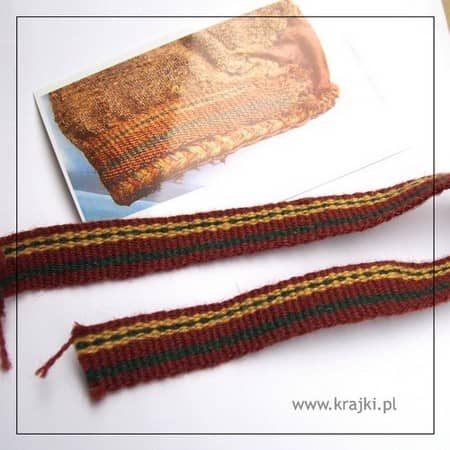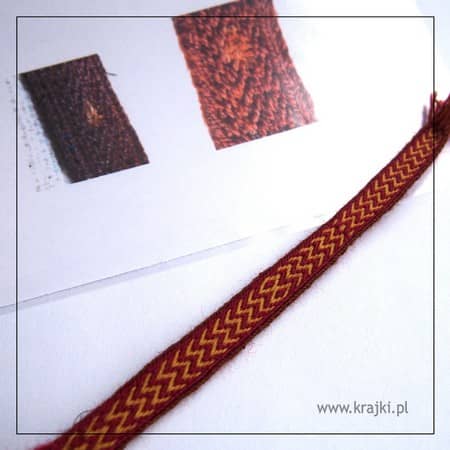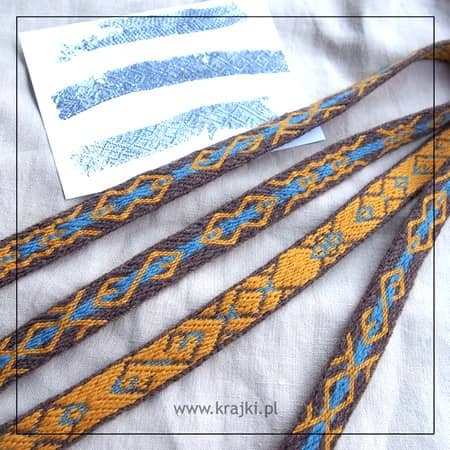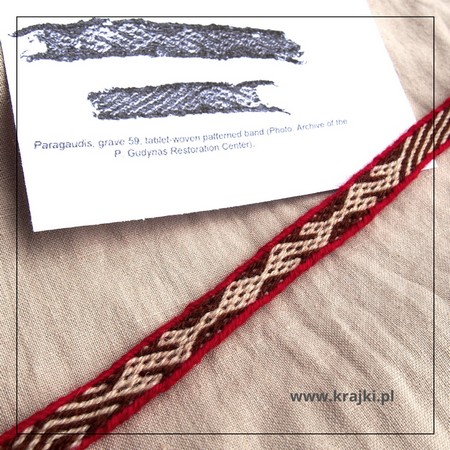Tablet woven bands from Northern Europe
Below you will find a selection of tablet woven bands from broadly defined Norhern Europe.
All replicas of the original finds pictured on our webpage have been woven by us. The photos of the original finds we collect in printed form were found mostly on the internet hence it is often not possible for us to determine the author of them or point to a particular source like a research paper or a book. However, we give the reference list below of the sources we have had access to in the past few years and from which we derived information about tablet woven band finds.
Most woven bands we offer through our shop are very close to the originals in terms of a pattern and technique. Some of the weavings presented here were originally silver or gold brocaded – yet currently we do not take commissions for brocaded bands. Instead, in our online shop you can order woolen or linen versions of different finds. These versions are often slightly simplified compared to the original bands but they seem to be a reasonable compromise between an attempt to reconstruct a medieval textile fragment with all its technical complexity (+ authenticity) and a price acceptable for a wide range of re-enactors and enthusiasts of history.

1. Seyðisfjörður, Island, 10-11th c.
Woolen band of about 1,5 cm width found during the recent archaeological excavation near the fishing village in the East Fjords of Iceland.
Similar Patterns in our shop

2. Ketilsstaðir, Island, 10th c.
Woolen band from the find known as „Lady in Blue” find or „Bláklædda Konan. The band decorated the upper edge of a blue apron dress.
Similar Patterns in our shop

3. Oseberg, Norway, 9th c.
Very narrow band (about 0.6 cm wide) originally woven from silk and linen threads.
Similar Patterns in our shop

4. Kaupang, Norway, 9-10th c.
This trim was originally woven from very fine woolen yarn, its width was under 1 cm.
Similar Patterns in our shop

5. Skjoldehamn, Norway, 10th c.
Woven from wool in plain weave (tabby). Originally about 2 cm wide.
Similar Patterns in our shop

6. Snartemo, Norway 5th c.
Narrow (under 1 cm wide) woolen band from Migration Period found in Southern Norway, possibly a decorative trim on the outer garment.
Similar Patterns in our shop

7. Vestrum, Norway, 5th-8th c.
Very narrow band from Vestrum in Vestfold, Norway (about 7 mm wide), woven from wool with the mix of 2-hole and 4-hole threading. Earlier dated to Migration Period, now to the Late Iron Age.
Similar Patterns in our shop

8. Mammen, Denmark, 10th c.
A band originally of about 1.5 cm width and woven from half wool and half vegetable-fiber thread (probably linen). Found in a Viking chieftan grave near Viborg.
Similar Patterns in our shop

9. Birka, Sweden, 9-10th c.
About 60 tablet woven bands with over 20 different patterns have been found in Birka (Sweden). Most of them are woven in silk (some are linen) and brocaded with silver and gold wire.
Similar Patterns in our shop

10. Dublin, Ireland, 10th c.
Similar Patterns in our shop

11. Cambridge, England, 5th c.
This Anglo-Saxon piece was found in Cambridge, it was attached to a metal strap end suggesting its use as a belt. The band was woven from linen and measured 11 mm width.
Similar Patterns in our shop

12. Køstrup, Denmark, 9-10th c.
Similar Patterns in our shop

13. Paragaudis, Lithuania, 10th c.
Woolen band found in female grave – the original band shows reddish edges and brown-grey pattern.
Similar Patterns in our shop
Sources and references:
(et al, 2015, “Bláklædda Konan – Ný Rannsókn Á Fornu Kumli” “Bundled-up in Blue . The Re-investigation Of A Viking Grave”, Ritaskrá Þjóðminjasfns Íslands, pp 11-12. )
https://northernwomen.org/project-2/
Collingwood, Peter, The Techniques of Tablet Weaving. London: Faber and Faber, 1982.
Crowfoot, Elizabeth and Sonia Hawkes. „Early Anglo-Saxon Gold Braids.” Medieval Archaeology XI (1967): 42-86.
Geijer, Agnes. Birka III: Die Textilfunde. Uppsala: Almqvist & Wiksells Boktryckeri, 1938.
Hald, Margrethe. Ancient Danish Textiles from Bogs and Burials. Copenhagen: National Museum of Denmark, 1980.
Ingstad, A. S. 1979. To kvinnegraver med tekstiler fra Kaupang. Universitetets Oldsaksamling 150 år, Jubileumsårbok. Særtrykk, Oslo.
Knudsen, Lise Ræder „Det uldne bånd fra Mammengraven”. In Mette Iversen (red.):Mammen, grav, kunst og samfund i vikingetiden. Jysk Arkæologisk Selskabs Skrifter XXVII. Viborg 1991, 149 – 150.
Knudsen, Lise Ræder: „Brocaded Tablet Woven Bands: Same Appearance, Different Weaving technique, Hørning, Hvilehøj and Mammen.” in: North European Symposium for Archaeological Textiles VII. Edinburg 1999, 36-43.
Nockert, Margareta. The Hogom Find and Other Migratioin Period Textiles and Costumes in Scandinavia. Umea: University of Umea, 1991
Pečeliūnaitė-Bazienė, E. (2010) „Textiles from the 3rd -12th century AD cremation graves found in Lithuania”. In E. Andersson Strand, M. Gleba, U. Mannering, C.Munkholt and M. Ringgaard (eds.), North EuropeanSymposium for Archaeological Textiles X, Ancient Textiles Series 5, 189-194. Oxford: Oxbow
Sveinsdottir, D. & Saemundarson, B. (2020). A Simplified Guide to Historical Tablet Weaving. Sydney, Australia: Knarr Traders.


























































